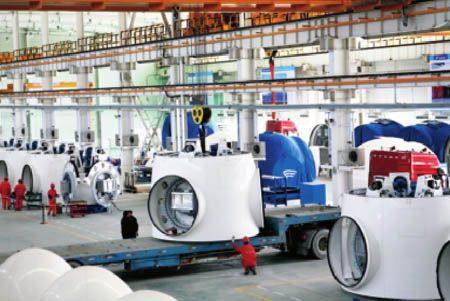Hami: Going Green on the Silk Road



MENTION “Hami” and invariably the first thing that comes to the mind for most Chinese is the regions namesake melon – hamigua. Famous for its fragrance and high sugar content, hamigua is the undisputed king of the domestic melon market. But the charm of Hami goes far beyond its tasty fruit.
Located in the eastern part of Xinjiang Uygur Autonomous Region, Hami Prefecture was an important locale on the ancient Silk Road. The area hasnt lost its importance, and Hami is now considered as the eastern gateway into Xinjiangs vast territory. Its “crossroads” geographic location means Hami thrives – as it has done for thousands of years – on trade passing from the East to the West and vice versa.
Hami has an area of 153,000 square kilometers and a population of 584,000, 31 percent of which represents ethnic minorities.
The towering Tianshan Mountains divide Hami into two parts along an east-west axis. The mountains control the local climate and rainfall, allowing visitors to appreciate a variety of landscapes, including snow-capped peaks, deserts and grasslands, without much traveling. A rich diversity of sceneries explains why this corner of China receives nearly two million visitors every year, though overseas tourists account for only 10,000 of them.
The last few years have seen leapfrog development in Hami. Its GDP reached RMB 22 billion (US $3.48 billion) in 2011, up 22 percent from the previous year. A GDP per capita of RMB 37,671 means Hami is an above-average economic performer in China.
“The annual per capita income of urban residents stands at RMB 15,600, while that of rural residents is RMB 7,100. We expect GDP to increase by 18 percent by the end of this year. This GDP growth rate is actually the highest in Xinjiang,” said Zhang Wenquan, deputy secretary of the CPC Hami Prefectural Committee.
“People cant say they know China without coming to Xinjiang, and you cant say you know Xinjiang without a visit to Hami,” he added.
A “Green” Desert
Promising growth figures demand Hami exploit its resources rationally and in a sustainable fashion. Nowadays Hamis authorities are focusing on tapping such sectors as coal, coal chemicals, power and wind energy.
During an interview with China Today, Zhang Wenquan noted his administration had five short-term goals: attracting more investment, increasing profits with a focus on environmental protection, increasing productivity, ensuring sustainable exploitation of resources, and promoting water conservation in Xinjiang, a region with vast deserts.
In todays world sustainable growth and job creation go hand in hand. As former Prime Minister of Netherlands Jan Peter Balkenende pointed out in his address at the second China-Eurasia Expo, held in Urumqi in September, green industries can and should create jobs. Chinese Premier Wen Jiabao also said at the Expo that the development of green industries should help China achieve greater efficiency, competitiveness and sustainability in its development towards the year 2020.
Over the past three years the emerging industries in Hami have created over 10,000 jobs. Zhang Wenquan emphasized that Hami boasts many advantages for the development of green industries in particular. These include its location in the desert, where sunshine and strong winds are the norm. The development of wind and solar power facilities in the area is a logical move, and a green Hami should provide promising opportunities for domestic and foreign investors.
Solar Energy Utilization
Hami has carried out many projects to utilize the solar energy potential of its vast desert surroundings. One example is the Hami Photovoltaic Industrial Park. We arrived at the park in the scorching midday sun, and were surprised to see snow on the peaks of the Tianshan Mountains in the distance.
With rapid development of the photovoltaic industry, the industrial park under construction has become a promising green power initiative in Hami. Dotting the desert landscape are hi-tech solar panels, whose technology is the same as that employed by bestpractice solar power providers in Germany, the U.S. and Spain.
“The project will be completed in several months. It is designed to produce enough electricity for the region, with a surplus to be fed into the grid and supplied to other parts of the country,” said Wang Junxin, a supervisor at the industrial park. The potential to export Chinas growing know-how in the field of large-scale alternative energy infrastructure projects has also been attracting the attention of Eurasian countries.
Riding the Wind
We knew Hami to be one of the“big seven” wind power bases in China, but visiting the Huaneng Renewables Wind Farm in Balikun County was still an awe-inspiring experience. In a wind-swept valley, turbine-sentinels fanned out as far as the eye could see. Each one was spinning at top speed in winds so strong we had to battle just to stay on our feet.
The installed capacity of the wind farm is 50,000 kW. The first phase of construction was finished in 2011 at a cost RMB 400 million. The second phase of the project is expected to be completed next year, and involves the same investment outlay.
“Solar and wind energies are very important to Hami. Each year we receive more than 3,000 hours of sunlight. Lhasa in Tibet is famous for its abundant sunshine, but we have more. There is no doubt that solar and wind energies are essential and hold great prospects for the development of Hami in general,” said Zhang Wenquan.
“Black Gold”
Green energy is key to the sustainable development of Hami, but the region also boasts abundant coal reserves. Its proven reserves account for 12.5 percent of the national total and 31.7 percent of Xinjiangs total. Using coal in a sustainable way alongside green alternatives is a local development imperative.
A good example of such development can be found at the Dananhu Power Plant, a project started in 2003 to generate coal-based electricity.
The Dananhu Power Plant is located in Hamis Industrial Development Zone. It has 400 employees, 80 percent of whom are locals.
General manager at the Dananhu Power Plant Feng Xiaoming told China Today that the plant currently only provides electricity to Xinjiang, but will soon begin selling its power surplus to the rest of the country. According to the plants development plan, the first step is to develop a new coal mine this year.
One green feature of the plant is its use of air in internal cooling. By avoiding the water-cooling system common to most power generation facilities, the Dananhu plant saves Hamis limited water resources for the regions population.
Yiwu County in Hami Prefecture is another locality utilizing the abundant resources it has at its disposal. The county has a population of 22,000, and most of its territory falls inside the Gobi desert. The population is so small relative to the size of the county that, when walking the streets at nightfall its hard to believe one is in China. Unlike most of Chinas cities and towns, there are few pedestrians to be seen, and the county town is entirely free of traffic lights. Its a breath of fresh air from the hustle and bustle of Chinas metropolises.
Not long ago a coalmine was opened here. It has turned out to be a godsend that has brought a wave of investment to the county. By estimation, the GDP of Yiwu County will reach RMB 1.2 billion (US $190 million) by the end of the 12th Five-year Plan period (2011-2015).
The Guanghui New Energy Company in the suburban area of Yiwu County has similarly spurred an influx of investment in the region. It specializes in extracting dimethyl ether, methanol and liquefied natural gas from coal.
“Our business plan was approved in 2010 by the National Development and Reform Commission of China. We produce 1.2 million tons of methanol, 850,000 tons of dimethyl ether and 500,000 cubic meters of liquefied natural gas – a green fuel – every year,” said Wang Fang, deputy manager of the company.
Hamis path to development has already been mapped out, with wind, solar, green fuels and smart use of coal leading the way.
The Silk Road was an inspiring chapter in the history of Hami. Now, as its green power initiatives blossom, perhaps its time to add a grand new chapter to the regions historic legacy.

